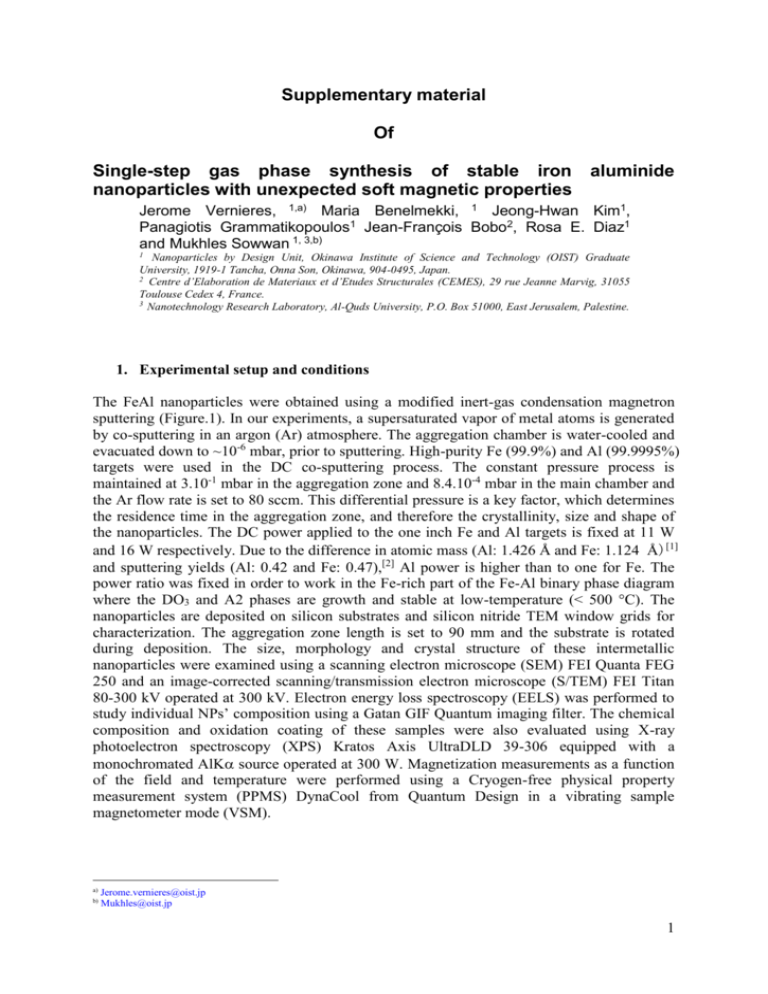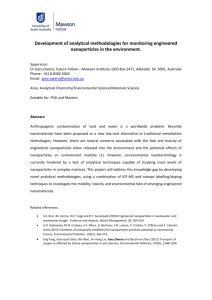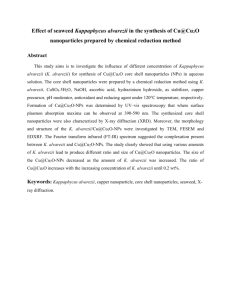supplementary-material
advertisement

Supplementary material Of Single-step gas phase synthesis of stable iron aluminide nanoparticles with unexpected soft magnetic properties Jerome Vernieres, 1,a) Maria Benelmekki, 1 Jeong-Hwan Kim1, Panagiotis Grammatikopoulos1 Jean-François Bobo2, Rosa E. Diaz1 and Mukhles Sowwan 1, 3,b) 1 Nanoparticles by Design Unit, Okinawa Institute of Science and Technology (OIST) Graduate University, 1919-1 Tancha, Onna Son, Okinawa, 904-0495, Japan. 2 Centre d’Elaboration de Materiaux et d’Etudes Structurales (CEMES), 29 rue Jeanne Marvig, 31055 Toulouse Cedex 4, France. 3 Nanotechnology Research Laboratory, Al-Quds University, P.O. Box 51000, East Jerusalem, Palestine. 1. Experimental setup and conditions The FeAl nanoparticles were obtained using a modified inert-gas condensation magnetron sputtering (Figure.1). In our experiments, a supersaturated vapor of metal atoms is generated by co-sputtering in an argon (Ar) atmosphere. The aggregation chamber is water-cooled and evacuated down to ~10-6 mbar, prior to sputtering. High-purity Fe (99.9%) and Al (99.9995%) targets were used in the DC co-sputtering process. The constant pressure process is maintained at 3.10-1 mbar in the aggregation zone and 8.4.10-4 mbar in the main chamber and the Ar flow rate is set to 80 sccm. This differential pressure is a key factor, which determines the residence time in the aggregation zone, and therefore the crystallinity, size and shape of the nanoparticles. The DC power applied to the one inch Fe and Al targets is fixed at 11 W and 16 W respectively. Due to the difference in atomic mass (Al: 1.426 Å and Fe: 1.124 Å)[1] and sputtering yields (Al: 0.42 and Fe: 0.47),[2] Al power is higher than to one for Fe. The power ratio was fixed in order to work in the Fe-rich part of the Fe-Al binary phase diagram where the DO3 and A2 phases are growth and stable at low-temperature (< 500 °C). The nanoparticles are deposited on silicon substrates and silicon nitride TEM window grids for characterization. The aggregation zone length is set to 90 mm and the substrate is rotated during deposition. The size, morphology and crystal structure of these intermetallic nanoparticles were examined using a scanning electron microscope (SEM) FEI Quanta FEG 250 and an image-corrected scanning/transmission electron microscope (S/TEM) FEI Titan 80-300 kV operated at 300 kV. Electron energy loss spectroscopy (EELS) was performed to study individual NPs’ composition using a Gatan GIF Quantum imaging filter. The chemical composition and oxidation coating of these samples were also evaluated using X-ray photoelectron spectroscopy (XPS) Kratos Axis UltraDLD 39-306 equipped with a monochromated AlK source operated at 300 W. Magnetization measurements as a function of the field and temperature were performed using a Cryogen-free physical property measurement system (PPMS) DynaCool from Quantum Design in a vibrating sample magnetometer mode (VSM). a) b) Jerome.vernieres@oist.jp Mukhles@oist.jp 1 Figure S1. Schematic diagram of the modified inert-gas condensation magnetron cosputtering showing the two Fe target and Al target. The diagram is divided into three parts: the aggregation zone where nucleation of Fe and Al cluster took place and following by coalescence to create larger nanoparticles, the aperture (red) where the as-nucleated alloy nanoparticles pass through to reach the main chamber where the nanoparticles are deposited on the substrate. 2. EELS measurements Figure S2. EELS spectra obtained from different area of the representative nanoparticles. The nanoparticle is composed of a bright core surrounded by a shell which is less shiny. The 2 identification of each element depends on the difference in contrast in ADF image which is related to the atomic number, the Fe-Al core rich in Fe is demonstrated by the bright contrast. Spatially resolved chemical information from these nanoparticles was acquired by obtaining EELS spectrum from a series of points across the representative NP in a STEM configuration (Core-loss spectra (a) and low-loss spectra (b)). STEM-EELS spectrum of area 1, 2 and 3 show the presence of Fe, Al and O within the NP. As can be seen in (a) and (b), the area 1 shows a strong edge of Fe-L2,3 corresponding to the position of the bright core, whilst the spectra on either side (area 2 and area 3) of the core are dominated by Al-L2,3 and O-K edge. 3. Crystal phase Figure S3. Simulated X-ray powder diffraction pattern (a) of the DO3 structure (b) and the corresponding electron diffraction pattern in [00-1] zone axis (c) (™Crystal maker). The DO3 is a derivative-bcc structure consisting in four interpenetrating fcc sublattices. The reflections in the FFT analysis (Fig. 2) are comparable to those reflections in the simulated diffraction pattern in Figure S3. It can be seen that all of the calculated lattices spacing and angles in the FFT (Fig. 2) matches perfectly with those values obtained by Crystal maker (Table S1). Further, the calculated lattice parameter with experimental d-spacing (5.769) is in good agreement with the known lattice parameter (5.792) [3]. It is important to note that the small difference in lattice parameter can be explained by compressive strain in small size nanoparticles. 3 Table S1. Calculated values from the FFT analysis and simulated values by Crystal maker of the corresponding d-spacing and angles. The lattice constant used for the theoretical value is 5.792 Å.[3] DO3 phase Calculated from FFT (Fig. 2) hkl dhkl (Å) 220 2.04 400 1.46 220 2.04 620 0.93 400 1.46 620 0.93 220 2.04 440 1.025 Angles (deg.) 46 26 20 90 Simulated values dhkl (Å) Angles (deg.) 2.0478 1.448 2.0478 0.9158 1.448 0.9158 2.0478 1.0239 45 26.57 18.43 90 4. Harvesting procedure Figure S4. Harvesting procedure employed for coated the magnetic nanoparticles with Gum Arabic (GA). Step 1: For the gum arabic (GA) film, a glass slide substrate (76 mm x 26 mm) was thoroughly rinsed in dry ethanol for 10 min under ultrasonication, then dried under N2 gas. 10 mg of GA (Sigma-Aldrich, St. Louis, US) was dispersed in 250 μL of deionized (DI) water solution and gently dispensed onto the cleaned glass substrate. A thin GA film was 4 formed by a spin-coater (MS-A-150, MIKASA, Japan) operated at 3,000 rpm for 30 sec. Step 2: NPs were exfoliated by immersing the NPs/GA/glass samples in DI water and sonicating for 15 min, followed by a separation step to remove the excessive GA polymer using a centrifuge at 100,000 rpm for 60 min. Step 3: After washing the precipitated NPs with 50% methanol in DI water, the NPs were re-dispersed in DI water from a Milli-Q system (Nihon Millipore K.K., Tokyo, Japan) using 0.1 μm filters. References [1] J. Yang, W. Hu, J. Tang and X. Dai, Comp. Mater. Sci., 2013, 74, 160-164. [2] www.iap.tuwien.ac.at/www/surface/sputteryield, A simple sputter yield calculator, accessed October 2013. [3] X. Shu, W. Hu, H. Xiao, H. Deng and B. Zhang, J. Mater. Sci. Technol., 2001, 17, 601-604. 5







